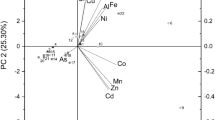Abstract
Concentrations of riboflavin — a vitamin essential for maricultured animals—were measured in six species of microalgae commonly used in mariculture. These were two diatoms (Chaetoceros gracilis, Thalassiosira pseudonana); two prymnesiophytes (Isochrysis sp. (clone T.ISO),Pavlova lutheri); one chlorophyte (Nannochloris atomus) and one eustigmatophyte (Nannochloropsis oculata). Cultures were analysed during both logarithmic and stationary growth phase.
The proportions of riboflavin (µg g-1 dry weight) during logarithmic growth-phase ranged from 20 (T. pseudonana) to 40 µg g-1 (Isochrysis sp. T.ISO). With the onset of stationary phase, the proportion of riboflavin increased in all species; the increase was most dramatic in cultures ofC. gracilis, T. pseudonana andN. atomus (2- to 3-fold).Chaetoceros gracilis contained more riboflavin (106 µg g-1) than all other species (48 to 61 µ g-1).
Despite the differences in the composition of the different microalgae, across both logarithmic and stationary growth-phases, all species should provide a rich source of riboflavin for maricultured animals.
Similar content being viewed by others
References
Amezaga MR, Knox D (1990) Riboflavin requirements in on-growing trout,Oncorhynchus mykiss. Aquaculture 88: 87–98.
Brown MR (1991) The amino-acid and sugar composition of 16 species of microalgae used in mariculture. J. exp. mar. Biol. Ecol. 145: 79–99.
Brown MR, Jeffrey SW, Garland CD (1989) Nutritional aspects of microalgae used in mariculture: a literature review. CSIRO Mar. Lab. Rep., No. 205, 44 pp.
Brown MR, Miller KA (1992) The ascorbic acid content of eleven species of microalgae used in mariculture. J. appl. Phycol. 4: 205–215.
Dawson KR, Unklesbay NF, Hedrick HB (1988) HPLC Determination of riboflavin, niacin and thiamin in beef, pork, and lamb after alternate heat processing methods. J. Agric. Food Chem. 36: 1176–1179.
De Roeck-Holtzhauer Y, Quere I, Claire C (1991) Vitamin analysis of five planktonic microalgae and one macroalga. J. appl. Phycol. 3: 259–264.
Enright CT, Newkirk GF, Craigie JS, Castell JD (1986) Evaluation of phytoplankton as diets for juvenileOstrea edulis L. J. exp. mar. Biol. Ecol. 96: 1–13.
Halver JE (1989) The vitamins. In Halver JE (ed.) Fish nutrition. Academic Press Inc., San Diego: 31–109.
Houng-Yung C, Hwang G (1992) Riboflavin requirement of juvenilePenaeus monodon. In Aquaculture '92: Growing toward the 21st Century. Conference Proceedings of Aquaculture '92, Orlando, Florida, USA: 60.
Jeffrey SW (1980) Cultivating uni-cellular marine plants. In CSIRO Division of Fisheries and Oceanography Research Report, 1977–1979: 22–43.
Lin DS, Ilias AM, Connor WE, Caldwell RS, Cory HT, Daves GD (1982) Composition and biosynthesis of sterols in selected marine phytoplankton. Lipids 17: 818–824.
Soliman AK, Wilson RP (1992) Water-soluble vitamin requirements of tilapia. 2. Riboflavin requirement of blue tilapiaOreochromis aureus. Aquaculture 104: 309–314.
Thompson PA, Harrison PJ, Whyte JNC (1990) Influence of irradiance on the fatty acid composition of phytoplankton. J. Phycol. 26: 278–288.
Volkman JK, Jeffrey SW, Nichols PD, Rogers GI Garland CD (1989) Fatty acids and lipid classes of 10 species of microalgae used in mariculture. J. exp. mar. Biol. Ecol. 128: 219–240.
Watanabe T, Kitajima C, Fujita S (1983) Nutritional values of live organisms used in Japan for mass propagation of fish: a review. Aquaculture 34: 115–143.
Webb KL, Chu FE (1983) Phytoplankton as a food source for bivalve larvae. In Pruder GD, Langdon CJ, Conklin DE (eds), Proc. 2nd Int. Conf. Aquaculture Nutrition, World Mariculture Society, Spec. Publ. No. 2, Louisiana State University, Louisiana: 272–291.
White A, Handler P, Smith EL, Hill R, Lehman IR (1979) The water soluble vitamins. In Jeffers JD, Macnow A, LaBarbera M, Armstrong T (eds), Principles of Biochemistry, 6th edition, McGraw-Hill, New York: 1333–1361.
Whyte JNC (1987) Biochemical composition and energy content of six species of phytoplankton used in mariculture of bivalves. Aquaculture 60: 31–241.
Author information
Authors and Affiliations
Additional information
Author for correspondence
Rights and permissions
About this article
Cite this article
Brown, M.R., Farmer, C.L. Riboflavin content of six species of microalgae used in mariculture. J Appl Phycol 6, 61–65 (1994). https://doi.org/10.1007/BF02185905
Received:
Accepted:
Issue Date:
DOI: https://doi.org/10.1007/BF02185905




